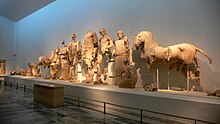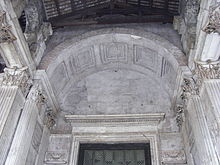Tympanum (architecture)


The tympanum or tympanum ( plural tympana ; from ancient Greek τύμπανον týmpanon , originally 'hand drum') is a decorative surface in architecture in gable triangles or in the arched field of portals .
history
Antiquity
In ancient architecture , especially in temple construction , the tympanum is the triangular gable surface, which was emphasized because of its size and frontality and provided with figurative or ornamental decoration. At Greek temples, this decoration often consists of three-dimensional figures. Initially, the gables were filled with powerful reliefs, such as on soon after 600 BC. Artemis temple in Kerkyra , whose west gable occupies the center of the gorgon Medusa with her children, flanked by panthers. Slightly shifted into the spandrels of the gable field, smaller scenes are depicted, such as Zeus hurling lightning bolts fighting giants . Almost free plastic, but still characterized by lions facing each other, is also the one around 570 BC. Chr. Gable decoration of the first ring hall temple on the Athens Acropolis , in whose spandrels Heracles, among others, fights against Triton . After the middle of the 6th century BC The composition scheme changes and the animal groups are now placed in the gusset before they disappear completely from the gables. The central composition is now occupied by battles between the gods or lined up groups of figures. The appreciation that was shown for these figure gables is evident in the discovery of the figures from the late Archaic Temple of Apollo in Delphi , whose gable sculptures were made after the temple was destroyed in 373 BC. Were literally buried. The local reference is increasingly emerging as the theme of the individual gable representations. The east gable of the Temple of Zeus in Olympia shows the preparations for the chariot race between Pelops and Oinomaos , the mythical ruler of Pisa near Olympia ; it is the original myth of the sanctuary itself that is shown here in the most prominent position. And it is similar with the birth of Athena in the east gable of the Parthenon or the dispute over the Attic land between Athena and Poseidon on its west side. On the gable of the younger Kabir temple in Samothrace from the late 3rd century BC. Finally, a purely local cult legend of the sanctuary was presented, which was of no overriding interest for Greece.
At Roman temples , the gable figures step back in favor of a relief or the gable fields remain unadorned and figure-less.

middle Ages
In Christian church buildings, the tympanum is located as a semicircular or pointed arched arch field above the portals . This place becomes the focal point of the sculptural jewelry on the Romanesque and Gothic churches. After forerunners at the end of the 11th century in Spain, the first high points of Romanesque relief art quickly emerged in the south of France at the Tympana of St. Sernin in Toulouse (Porte Miègeville, around 1115), of St. Pierre in Moissac with its visionary expressive power and its excited Stylization, then in Burgundy: the huge tympanum of Cluny III , which was destroyed except for minimal fragments, followed by St. Madeleine in Vézelay with a dispatch of the Apostles, also very moved in its forms, then that of Autun with the more delicate, soulful figurations in a judgment day . Roman Tympanonreliefs dominantly Christ in Majesty motifs in a winged angels carried by or from the four evangelists or their symbolic figures accompanied Mandorla or Judgment representations on. A popular picture scheme for smaller picture fields is the figure of Christ flanked by saints (especially Peter and Paul). Figures on German tympana did not appear until around 1230 with the transition from Romanesque to Gothic. Outstanding early German tympana: Freiberg, Goldene Pforte (around 1230), Strasbourg Cathedral, south transept portal (around 1230), Bamberg Cathedral, Fürstenportal (around 1230–1240). In the case of Gothic churches, the range of topics expands, mariological representations such as the Assumption of Mary or the Coronation of Mary are added (preferably on north portals), towards the end of the Middle Ages also biblical events and legends of saints, the representation changes accordingly from symbolic to narrative, from the dominant central motifs to a dissolution into stripes arranged picture narrations.
Toulouse, St. Sernin , Porte Miègeville, around 1115
Chartres, cathedral, king portal , around 1150
Strasbourg Cathedral , south portal, Coronation of Mary, around 1220
Freiberg, Golden Gate , around 1230
Ulm Minster , west portal, creation story, around 1380
Others
Fields over doors, especially in modern architecture since the Renaissance, are known as over- portals .
- in Byzantium probably already decorated with mosaics in the 4th and 5th centuries ,
- in Romanesque churches partly unadorned (for example in north German field stone churches)
- from the Gothic - especially in Germany and France - richly decorated with reliefs; fully plastic figures also appear.
Tympanum art in Thailand
a) religious: scenes from the life of the Buddha
c) monarchical symbolism: the ruling Chakri dynasty , Royal Palace Bangkok
d) purely decorative: Wat Ratcha Orasaram , Bangkok
See also
Web links
- Bogenfeld in the Real Lexicon on German Art History (on post-ancient significance)
Individual evidence
- ↑ In rare cases - especially those in the north of the Auvergne (e.g. on the south portal of the Thuret priory church or on the west portal of the Saint-Martin church in Bellenaves ), a gable-shaped tympanum is inscribed in the actual semicircle.










